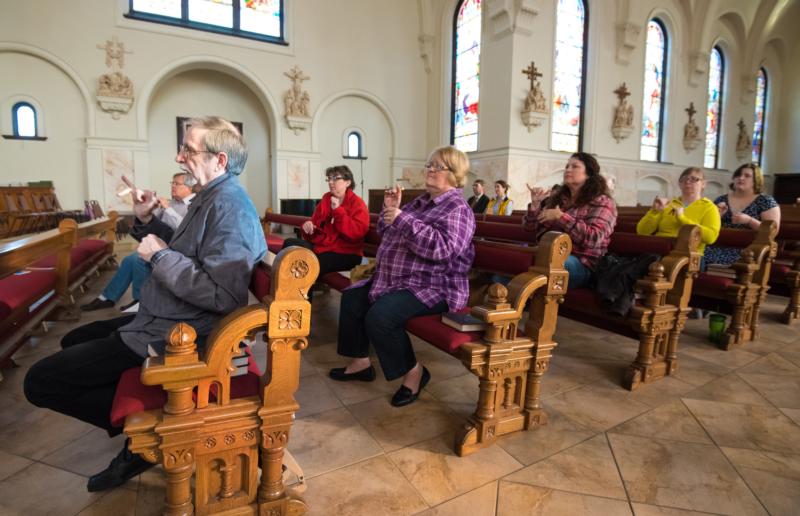
Members of the deaf community use sign language to participate in the Stations of the Cross held March 11, 2016, at St. John the Evangelist Church in Green Bay, Wis. Meditating on the Stations of the Cross is a traditional Lenten devotion. (CNS photo/Sam Lucero, The Compass)
Meditating on the Stations of the Cross is a traditional Lenten devotion. Picture yourself in the scene as you accompany Jesus along the Way of the Cross. What does he say? What do you say?
1. Jesus prays in agony in the Garden of Gethsemane.
“He said to them, ‘My soul is sorrowful even to death. Remain here and keep watch'” (Mk 14:34).
2. Jesus is betrayed by Judas and arrested.
“Then stepping forward they laid hands on Jesus and arrested him” (Mt 26:50).
[hotblock]
3. The Sanhedrin condemns Jesus.
“They said, ‘If you are the Messiah, tell us,’ but he replied to them, ‘If I tell you, you will not believe, and if I question, you will not respond” (Lk 22:67-68).
4. Peter denies Jesus three times.
“He began to curse and to swear, ‘I do not know this man about whom you are talking.’ And immediately a cock crowed a second time. Then Peter remembered the word that Jesus had said to him, ‘Before the cock crows twice you will deny me three times.’ He broke down and wept” (Mk 14:71-72).
5. Jesus is condemned to death.
“They persisted in calling for his crucifixion. … The verdict of Pilate was that their demand should be granted. So he released the man who had been imprisoned for rebellion and murder … and he handed Jesus over to them” (Lk 23:23-25).
6 Soldiers whip Jesus and crown him with thorns.
“And the soldiers wove a crown out of thorns and placed it on his head, and clothed him in a purple cloak, and they came to him and said, ‘Hail, King of the Jews!’ And they struck him repeatedly” (Jn 19:1-3).
[hotblock2]
7. Jesus carries the cross.
“So they took Jesus, and carrying the cross himself he went out to what is called the Place of the Skull, in Hebrew, Golgotha” (Jn 19:16-17).
8. Simon the Cyrenian helps Jesus carry the cross.
“As they were going out, they met a Cyrenian named Simon; this man they pressed into service to carry his cross” (Mt 27:32).
9. Jesus meets the women of Jerusalem.
“A large crowd of people followed Jesus, including many women who mourned and lamented him. Jesus turned to them and said, ‘Daughters of Jerusalem, do not weep for me; weep instead for yourselves and for your children'” (Lk 23:27-28).
10. Jesus is crucified.
“They crucified him and the criminals there, one on his right, the other on his left” (Lk 23:33).
11. Jesus promises his kingdom to the good thief.
“He said, ‘Jesus, remember me when you come into your kingdom.’ He replied … ‘Amen, I say to you, today you will be with me in paradise” (Lk 23:42-43).
12. Jesus speaks to his mother and the disciple.
“He said to his mother, ‘Woman, behold, your son.’ Then he said to the disciple, ‘Behold, your mother'” (Jn 19:26-27).
[hotblock3]
13. Jesus dies on the cross.
“He said, ‘It is finished.’ And bowing his head, he handed over the spirit” (Jn 19:30).
14. Jesus is placed in the tomb.
“Taking the body, Joseph (of Arimathea) wrapped it (in) clean linen and laid it in his new tomb” (Mt 27:59-60).
***
Capizzi is the special projects editor at Catholic News Service.
PREVIOUS: Staying focused on God’s good gifts, not life’s worries
NEXT: Seven ‘penitential’ psalms help in our conversion this Lent



Share this story